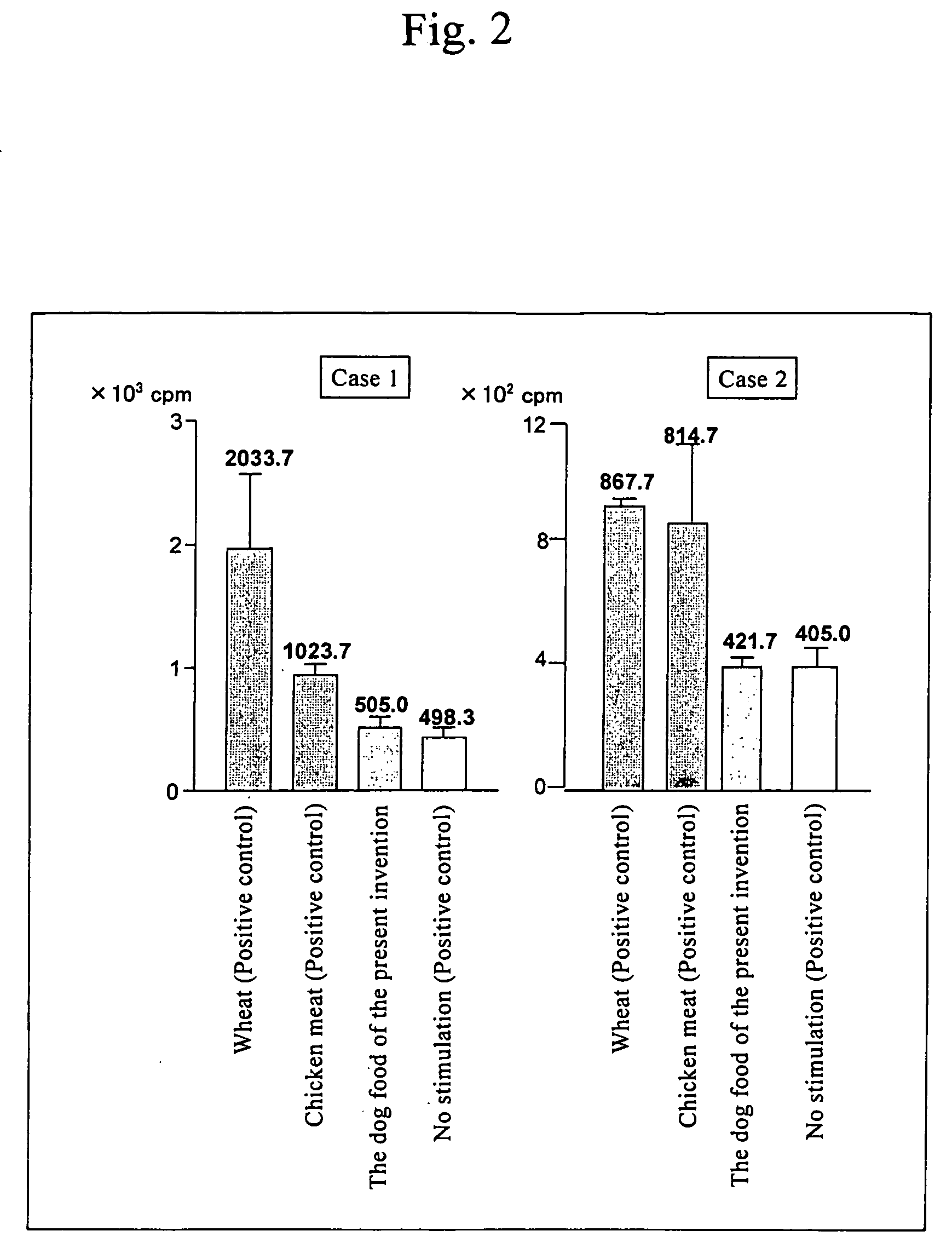Pet food for reducing food allergy reactions
a technology pet food, which is applied in the field of pet food for reducing food allergy reactions, can solve the problems of allergic reactions, increased risk of causing food allergy reactions, and development of inflammation or on the skin and mucosa, so as to reduce the occurrence of food allergy reactions, convenient feeding a pet
- Summary
- Abstract
- Description
- Claims
- Application Information
AI Technical Summary
Benefits of technology
Problems solved by technology
Method used
Image
Examples
example 1
[0036] (1) Raw materials for a dog food having a composition as listed in Table 1 were prepared.
TABLE 1Starch, dextrins, and saccharides57 parts by weightPotato protein10 parts by weightAmino acids* 7 parts by weightSoybean oil15 parts by weightCellulose 5 parts by weightVitamins and minerals 6 parts by weight
*Amino acids included alanine, arginine, asparagine, aspartic acid, methionine, cystine, cysteine, glutamic acid, glutamine, glycine, threonine, histidine, valine, leucine, isoleucine, lysine, tryptophan, phenylalanine, tyrosine, proline, serine, and taurine.
[0037] The amount of each amino acid used in Table I is as listed in Table 2 below.
TABLE 2Alanine1.50 parts by weightArginine1.00 parts by weightAsparagine0.10 parts by weightAspartic acid0.10 parts by weightMethionine0.40 parts by weightCystine0.10 parts by weightCysteine0.20 parts by weightGlutamic acid0.10 parts by weightGlutamine0.10 parts by weightGlycine1.00 parts by weightThreonine0.25 parts by weightHistidine0....
example 2
[0045] A dog food (dog food for food allergy) composed of raw materials as listed in Table 3 and Table 4 below was prepared according to the above Example 1. Dogs subject to food allergies were fed with this dog food and then the itching scores of these dogs were determined.
TABLE 3Starch and saccharides45 parts by weightPotato protein15 parts by weightAmino acids* 8 parts by weightSoybean oil17 parts by weightCellulose 7 parts by weightVitamins and minerals 8 parts by weight
[0046]
TABLE 4Alanine1.50 parts by weightArginine1.20 parts by weightMethionine0.40 parts by weightCysteine0.10 parts by weightGlycine1.20 parts by weightThreonine0.45 parts by weightHistidine0.10 parts by weightValine0.40 parts by weightLeucine0.60 parts by weightIsoleucine0.45 parts by weightLysine0.40 parts by weightTryptophan0.20 parts by weightPhenylalanine0.40 parts by weightTyrosine0.20 parts by weightSerine0.20 parts by weightTaurine0.20 parts by weight
*Amino acids contained
[0047] Table 5 and FIG. 10 sh...
example 3
[0066] Raw materials composing a dog food, as listed in Table 6 and Table 7 below, were prepared according to the above Example 1. In addition, the dog food is an example of a case in which amino acids were used instead of a protein raw material.
TABLE 6Starch, dextrins, and saccharides55 parts by weightAmino acids*14 parts by weightSoybean oil16 parts by weightCellulose 7 parts by weightVitamins and minerals 8 parts by weight
[0067]
TABLE 7Alanine1.00 parts by weightArginine1.30 parts by weightAspartic acid0.50 parts by weightMethionine0.70 parts by weightCysteine0.30 parts by weightGlutamic acid0.80 parts by weightGlutamine0.10 parts by weightGlycine1.20 parts by weightThreonine0.85 parts by weightHistidine0.35 parts by weightValine0.80 parts by weightLeucine1.30 parts by weightIsoleucine0.75 parts by weightLysine1.20 parts by weightTryptophan0.25 parts by weightPhenylalanine1.00 parts by weightTyrosine0.40 parts by weightProline0.40 parts by weightSerine0.60 parts by weightTaurine...
PUM
 Login to View More
Login to View More Abstract
Description
Claims
Application Information
 Login to View More
Login to View More - R&D
- Intellectual Property
- Life Sciences
- Materials
- Tech Scout
- Unparalleled Data Quality
- Higher Quality Content
- 60% Fewer Hallucinations
Browse by: Latest US Patents, China's latest patents, Technical Efficacy Thesaurus, Application Domain, Technology Topic, Popular Technical Reports.
© 2025 PatSnap. All rights reserved.Legal|Privacy policy|Modern Slavery Act Transparency Statement|Sitemap|About US| Contact US: help@patsnap.com



